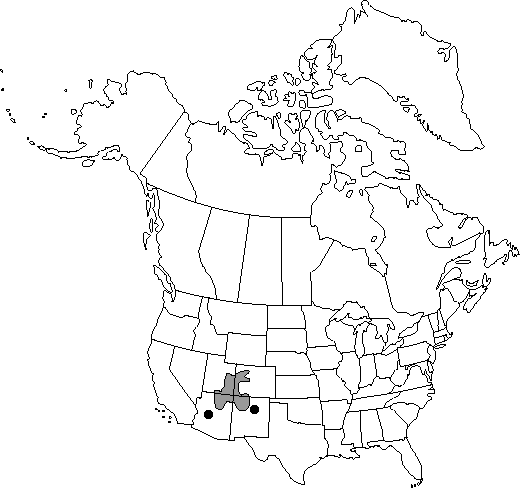Difference between revisions of "Ephedra cutleri"
J. Wash. Acad. Sci. 30: 473. 1940.
FNA>Volume Importer |
imported>Volume Importer |
||
| (6 intermediate revisions by 2 users not shown) | |||
| Line 8: | Line 8: | ||
}} | }} | ||
|common_names=Navajo ephedra | |common_names=Navajo ephedra | ||
| + | |special_status={{Treatment/ID/Special_status | ||
| + | |code=E | ||
| + | |label=Endemic | ||
| + | }} | ||
|basionyms= | |basionyms= | ||
|synonyms={{Treatment/ID/Synonym | |synonyms={{Treatment/ID/Synonym | ||
|name=Ephedra coryi var. viscida | |name=Ephedra coryi var. viscida | ||
|authority=Cutler | |authority=Cutler | ||
| − | }}{{Treatment/ID/Synonym | + | |rank=variety |
| + | }} {{Treatment/ID/Synonym | ||
|name=Ephedra viridis var. viscida | |name=Ephedra viridis var. viscida | ||
|authority=(Cutler) L. D. Benson | |authority=(Cutler) L. D. Benson | ||
| + | |rank=variety | ||
}} | }} | ||
|hierarchy=Ephedraceae;Ephedra;Ephedra cutleri | |hierarchy=Ephedraceae;Ephedra;Ephedra cutleri | ||
| Line 30: | Line 36: | ||
|elevation=1400–2300 m | |elevation=1400–2300 m | ||
|distribution=Ariz.;Colo.;N.Mex.;Utah. | |distribution=Ariz.;Colo.;N.Mex.;Utah. | ||
| − | |discussion=<p>The hybrid Ephedra × arenicola is discussed under E. torreyana.</p> | + | |discussion=<p>The hybrid <i>Ephedra</i> × arenicola is discussed under <i>E. torreyana</i>.</p> |
|tables= | |tables= | ||
|references= | |references= | ||
| Line 39: | Line 45: | ||
-->{{#Taxon: | -->{{#Taxon: | ||
name=Ephedra cutleri | name=Ephedra cutleri | ||
| − | |||
|authority=Peebles | |authority=Peebles | ||
|rank=species | |rank=species | ||
| Line 53: | Line 58: | ||
|publication title=J. Wash. Acad. Sci. | |publication title=J. Wash. Acad. Sci. | ||
|publication year=1940 | |publication year=1940 | ||
| − | |special status= | + | |special status=Endemic |
| − | |source xml=https:// | + | |source xml=https://bitbucket.org/aafc-mbb/fna-data-curation/src/2e0870ddd59836b60bcf96646a41e87ea5a5943a/coarse_grained_fna_xml/V2/V2_257.xml |
|genus=Ephedra | |genus=Ephedra | ||
|species=Ephedra cutleri | |species=Ephedra cutleri | ||
Latest revision as of 20:22, 5 November 2020
Shrubs rhizomatous, forming clumps, erect, 0.25–1.5 m, 3–5 m diam. Bark reddish brown, cracked and irregularly fissured. Branches alternate or whorled, rigid, angle of divergence about 25°. Twigs bright green, becoming yellow-green with age, viscid, ridges between longitudinal grooves papillate; internodes 1–5 cm. Terminal buds conic, 1–3 mm. Leaves opposite, 2–5 mm, connate to 1/4–1/2 their length; bases thickened, brown, persistent; apex setaceous. Pollen cones 2–several at node, obovoid, 4–6 mm, on very short, scaly peduncles (rarely sessile); bracts opposite, 5–9 pairs, light yellow, ovate, 2–4 × 2–3 mm, membranous, slightly connate at base; bracteoles slightly exceeding bracts; sporangiophores 2–4 mm, barely exserted, with 5–7 sessile to short-stalked (less than 1 mm) microsporangia. Seed cones 2–several at node, obovoid to nearly globose, 7–15 mm, peduncles 5–25 mm, with 1 pair of basal and 1 pair of nearly terminal bracts; bracts opposite, 3 or 4 pairs, ovate, 3–6 × 2–5 mm, membranous, with yellow center and base, margins entire. Seeds 2, ellipsoid, 5–8 × 2–4 mm, brown to chestnut, smooth.
Phenology: Coning late winter–midspring (Mar–May).
Habitat: Dry, flat, sandy areas, occasionally on rocky slopes
Elevation: 1400–2300 m
Distribution

Ariz., Colo., N.Mex., Utah.
Discussion
The hybrid Ephedra × arenicola is discussed under E. torreyana.
Selected References
None.